Ge Yan
SciDA: Scientific Dynamic Assessor of LLMs
Jun 15, 2025Abstract:Advancement in Large Language Models (LLMs) reasoning capabilities enables them to solve scientific problems with enhanced efficacy. Thereby, a high-quality benchmark for comprehensive and appropriate assessment holds significance, while existing ones either confront the risk of data contamination or lack involved disciplines. To be specific, due to the data source overlap of LLMs training and static benchmark, the keys or number pattern of answers inadvertently memorized (i.e. data contamination), leading to systematic overestimation of their reasoning capabilities, especially numerical reasoning. We propose SciDA, a multidisciplinary benchmark that consists exclusively of over 1k Olympic-level numerical computation problems, allowing randomized numerical initializations for each inference round to avoid reliance on fixed numerical patterns. We conduct a series of experiments with both closed-source and open-source top-performing LLMs, and it is observed that the performance of LLMs drop significantly under random numerical initialization. Thus, we provide truthful and unbiased assessments of the numerical reasoning capabilities of LLMs. The data is available at https://huggingface.co/datasets/m-a-p/SciDA
Rethinking Crowd-Sourced Evaluation of Neuron Explanations
Jun 09, 2025Abstract:Interpreting individual neurons or directions in activations space is an important component of mechanistic interpretability. As such, many algorithms have been proposed to automatically produce neuron explanations, but it is often not clear how reliable these explanations are, or which methods produce the best explanations. This can be measured via crowd-sourced evaluations, but they can often be noisy and expensive, leading to unreliable results. In this paper, we carefully analyze the evaluation pipeline and develop a cost-effective and highly accurate crowdsourced evaluation strategy. In contrast to previous human studies that only rate whether the explanation matches the most highly activating inputs, we estimate whether the explanation describes neuron activations across all inputs. To estimate this effectively, we introduce a novel application of importance sampling to determine which inputs are the most valuable to show to raters, leading to around 30x cost reduction compared to uniform sampling. We also analyze the label noise present in crowd-sourced evaluations and propose a Bayesian method to aggregate multiple ratings leading to a further ~5x reduction in number of ratings required for the same accuracy. Finally, we use these methods to conduct a large-scale study comparing the quality of neuron explanations produced by the most popular methods for two different vision models.
Evaluating Neuron Explanations: A Unified Framework with Sanity Checks
Jun 06, 2025Abstract:Understanding the function of individual units in a neural network is an important building block for mechanistic interpretability. This is often done by generating a simple text explanation of the behavior of individual neurons or units. For these explanations to be useful, we must understand how reliable and truthful they are. In this work we unify many existing explanation evaluation methods under one mathematical framework. This allows us to compare existing evaluation metrics, understand the evaluation pipeline with increased clarity and apply existing statistical methods on the evaluation. In addition, we propose two simple sanity checks on the evaluation metrics and show that many commonly used metrics fail these tests and do not change their score after massive changes to the concept labels. Based on our experimental and theoretical results, we propose guidelines that future evaluations should follow and identify a set of reliable evaluation metrics.
ThinkEdit: Interpretable Weight Editing to Mitigate Overly Short Thinking in Reasoning Models
Mar 27, 2025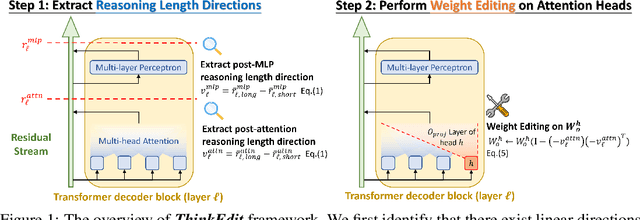

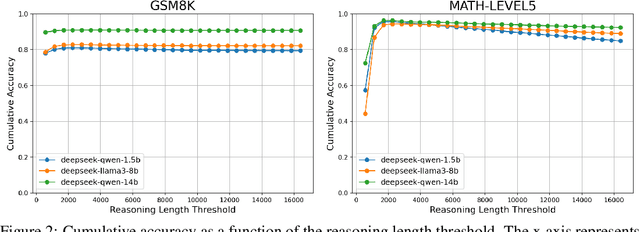

Abstract:Recent studies have shown that Large Language Models (LLMs) augmented with chain-of-thought (CoT) reasoning demonstrate impressive problem-solving abilities. However, in this work, we identify a recurring issue where these models occasionally generate overly short reasoning, leading to degraded performance on even simple mathematical problems. Specifically, we investigate how reasoning length is embedded in the hidden representations of reasoning models and its impact on accuracy. Our analysis reveals that reasoning length is governed by a linear direction in the representation space, allowing us to induce overly short reasoning by steering the model along this direction. Building on this insight, we introduce ThinkEdit, a simple yet effective weight-editing approach to mitigate the issue of overly short reasoning. We first identify a small subset of attention heads (approximately 2%) that predominantly drive short reasoning behavior. We then edit the output projection weights of these heads to suppress the short reasoning direction. With changes to only 0.1% of the model's parameters, ThinkEdit effectively reduces overly short reasoning and yields notable accuracy gains for short reasoning outputs (+5.44%), along with an overall improvement across multiple math benchmarks (+2.43%). Our findings provide new mechanistic insights into how reasoning length is controlled within LLMs and highlight the potential of fine-grained model interventions to improve reasoning quality. Our code is available at https://github.com/Trustworthy-ML-Lab/ThinkEdit
Interpretable Generative Models through Post-hoc Concept Bottlenecks
Mar 25, 2025Abstract:Concept bottleneck models (CBM) aim to produce inherently interpretable models that rely on human-understandable concepts for their predictions. However, existing approaches to design interpretable generative models based on CBMs are not yet efficient and scalable, as they require expensive generative model training from scratch as well as real images with labor-intensive concept supervision. To address these challenges, we present two novel and low-cost methods to build interpretable generative models through post-hoc techniques and we name our approaches: concept-bottleneck autoencoder (CB-AE) and concept controller (CC). Our proposed approaches enable efficient and scalable training without the need of real data and require only minimal to no concept supervision. Additionally, our methods generalize across modern generative model families including generative adversarial networks and diffusion models. We demonstrate the superior interpretability and steerability of our methods on numerous standard datasets like CelebA, CelebA-HQ, and CUB with large improvements (average ~25%) over the prior work, while being 4-15x faster to train. Finally, a large-scale user study is performed to validate the interpretability and steerability of our methods.
RAT: Boosting Misclassification Detection Ability without Extra Data
Mar 18, 2025Abstract:As deep neural networks(DNN) become increasingly prevalent, particularly in high-stakes areas such as autonomous driving and healthcare, the ability to detect incorrect predictions of models and intervene accordingly becomes crucial for safety. In this work, we investigate the detection of misclassified inputs for image classification models from the lens of adversarial perturbation: we propose to use robust radius (a.k.a. input-space margin) as a confidence metric and design two efficient estimation algorithms, RR-BS and RR-Fast, for misclassification detection. Furthermore, we design a training method called Radius Aware Training (RAT) to boost models' ability to identify mistakes. Extensive experiments show our method could achieve up to 29.3% reduction on AURC and 21.62% reduction in FPR@95TPR, compared with previous methods.
Humanoid Policy ~ Human Policy
Mar 17, 2025Abstract:Training manipulation policies for humanoid robots with diverse data enhances their robustness and generalization across tasks and platforms. However, learning solely from robot demonstrations is labor-intensive, requiring expensive tele-operated data collection which is difficult to scale. This paper investigates a more scalable data source, egocentric human demonstrations, to serve as cross-embodiment training data for robot learning. We mitigate the embodiment gap between humanoids and humans from both the data and modeling perspectives. We collect an egocentric task-oriented dataset (PH2D) that is directly aligned with humanoid manipulation demonstrations. We then train a human-humanoid behavior policy, which we term Human Action Transformer (HAT). The state-action space of HAT is unified for both humans and humanoid robots and can be differentiably retargeted to robot actions. Co-trained with smaller-scale robot data, HAT directly models humanoid robots and humans as different embodiments without additional supervision. We show that human data improves both generalization and robustness of HAT with significantly better data collection efficiency. Code and data: https://human-as-robot.github.io/
Movable Antenna Aided Multiuser Communications: Antenna Position Optimization Based on Statistical Channel Information
Feb 28, 2025



Abstract:The movable antenna (MA) technology has attracted great attention recently due to its promising capability in improving wireless channel conditions by flexibly adjusting antenna positions. To reap maximal performance gains of MA systems, existing works mainly focus on MA position optimization to cater to the instantaneous channel state information (CSI). However, the resulting real-time antenna movement may face challenges in practical implementation due to the additional time overhead and energy consumption required, especially in fast time-varying channel scenarios. To address this issue, we propose in this paper a new approach to optimize the MA positions based on the users' statistical CSI over a large timescale. In particular, we propose a general field response based statistical channel model to characterize the random channel variations caused by the local movement of users. Based on this model, a two-timescale optimization problem is formulated to maximize the ergodic sum rate of multiple users, where the precoding matrix and the positions of MAs at the base station (BS) are optimized based on the instantaneous and statistical CSI, respectively. To solve this non-convex optimization problem, a log-barrier penalized gradient ascent algorithm is developed to optimize the MA positions, where two methods are proposed to approximate the ergodic sum rate and its gradients with different complexities. Finally, we present simulation results to evaluate the performance of the proposed design and algorithms based on practical channels generated by ray-tracing. The results verify the performance advantages of MA systems compared to their fixed-position antenna (FPA) counterparts in terms of long-term rate improvement, especially for scenarios with more diverse channel power distributions in the angular domain.
Integrating LMM Planners and 3D Skill Policies for Generalizable Manipulation
Jan 30, 2025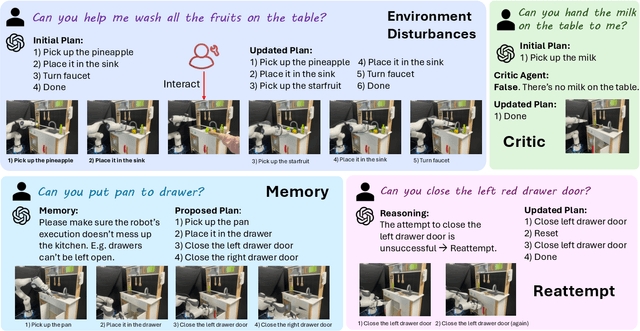
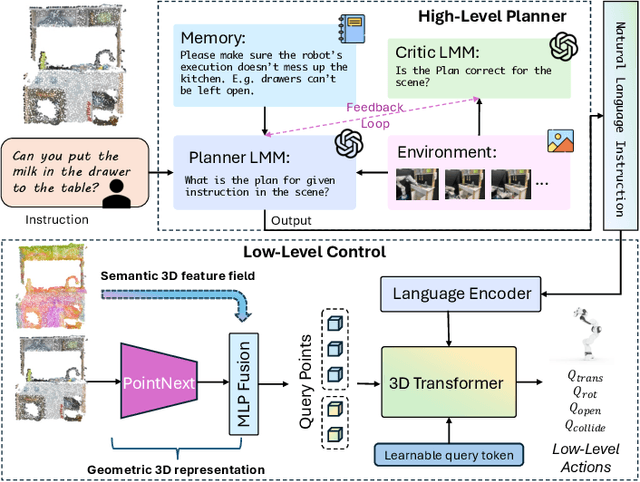

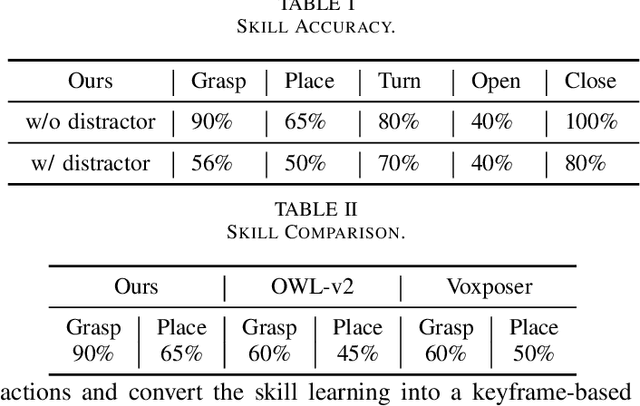
Abstract:The recent advancements in visual reasoning capabilities of large multimodal models (LMMs) and the semantic enrichment of 3D feature fields have expanded the horizons of robotic capabilities. These developments hold significant potential for bridging the gap between high-level reasoning from LMMs and low-level control policies utilizing 3D feature fields. In this work, we introduce LMM-3DP, a framework that can integrate LMM planners and 3D skill Policies. Our approach consists of three key perspectives: high-level planning, low-level control, and effective integration. For high-level planning, LMM-3DP supports dynamic scene understanding for environment disturbances, a critic agent with self-feedback, history policy memorization, and reattempts after failures. For low-level control, LMM-3DP utilizes a semantic-aware 3D feature field for accurate manipulation. In aligning high-level and low-level control for robot actions, language embeddings representing the high-level policy are jointly attended with the 3D feature field in the 3D transformer for seamless integration. We extensively evaluate our approach across multiple skills and long-horizon tasks in a real-world kitchen environment. Our results show a significant 1.45x success rate increase in low-level control and an approximate 1.5x improvement in high-level planning accuracy compared to LLM-based baselines. Demo videos and an overview of LMM-3DP are available at https://lmm-3dp-release.github.io.
Power Measurement Enabled Channel Autocorrelation Matrix Estimation for IRS-Assisted Wireless Communication
Jul 20, 2024Abstract:By reconfiguring wireless channels via passive signal reflection, intelligent reflecting surface (IRS) can bring significant performance enhancement for wireless communication systems. However, such performance improvement generally relies on the knowledge of channel state information (CSI) for IRS-involved links. Prior works on IRS CSI acquisition mainly estimate IRS-cascaded channels based on the extra pilot signals received at the users/base station (BS) with time-varying IRS reflections, which, however, needs to modify the existing channel training/estimation protocols of wireless systems. To address this issue, we propose in this paper a new channel estimation scheme for IRS-assisted communication systems based on the received signal power measured at the user terminal, which is practically attainable without the need of changing the current protocol. Due to the lack of signal phase information in measured power, the autocorrelation matrix of the BS-IRS-user cascaded channel is estimated by solving an equivalent rank-minimization problem. To this end, a low-rank-approaching (LRA) algorithm is proposed by employing the fractional programming and alternating optimization techniques. To reduce computational complexity, an approximate LRA (ALRA) algorithm is also developed. Furthermore, these two algorithms are extended to be robust against the receiver noise and quantization error in power measurement. Simulation results are provided to verify the effectiveness of the proposed channel estimation algorithms as well as the IRS passive reflection design based on the estimated channel autocorrelation matrix.
 Add to Chrome
Add to Chrome Add to Firefox
Add to Firefox Add to Edge
Add to Edge